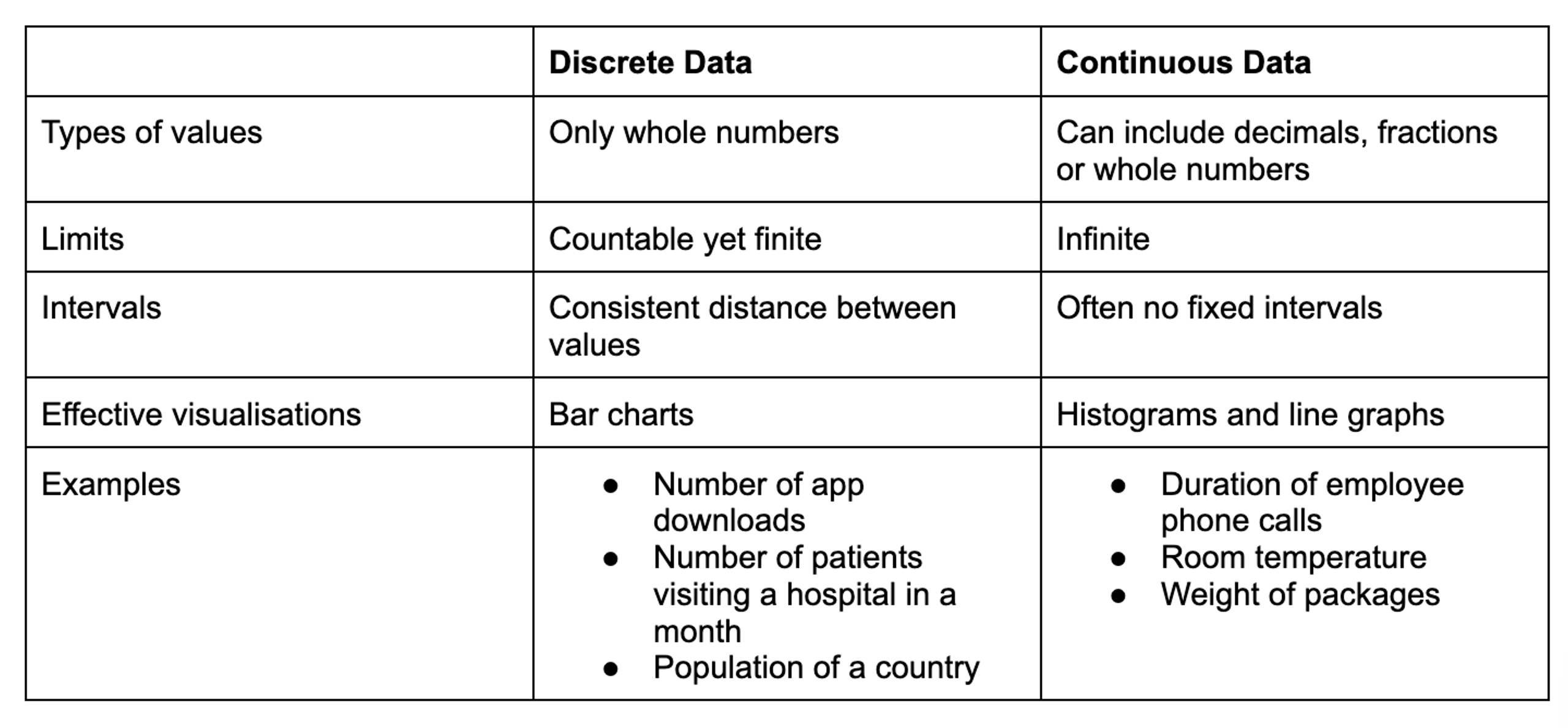Like the humans in the sci-fi movie Lucy, businesses don’t always use their data brains to their full potential. Quodea’s Data Maturity Report 2024(opens new window) found that 91% of UK IT leaders want to be more data-driven, but 73% struggle to use information effectively.
Learning how to analyse different kinds of information is essential for many different functional roles, regardless of where they sit in an organisation. The most common types every data professional encounters are:
- Categorical data – Describes non-numerical traits, such as gender and occupation
- Quantitative data – Numerical values like age and height
- Structured data – Information that follows a consistent format, such as phone numbers and bank account details
- Unstructured data – Less uniform data that doesn’t follow a set pattern, including photos and webpages
Data Analysts and Data Scientists rely on all four types of data to build models and make savvy decisions. Here’s an in-depth breakdown of their differences and applications — and practical guidance to help you use them in your business.
What is data?
Data refers broadly to all the pieces of information that businesses collect or produce. Practically anything can be considered data — as long as someone takes the time to observe or record it.
Most information falls into two categories:
- Qualitative data – Information that’s open to interpretation and described with language, e.g., photos and open-ended survey responses.
- Quantitative data – Measurable information that’s represented numerically, e.g., revenue, number of sales, and average customer rating.
Data has become an incredibly valuable resource for businesses in all industries. Just look at Salesforce’s iconic “Gold Rush” commercial(opens new window). “If AI is the Wild West,” Matthew McConaughey drawls from under his cowboy hat, “does that make data the new gold?”
While the ad might play off a bit silly, the analogy is on point. No, most businesses aren’t selling data like freshly-mined bars of gold. But they are using this information to make faster and more accurate decisions that directly impact their bottom lines.
Take Marks & Spencer(opens new window), for instance. The British retailer gathers customer feedback, demand indicators, and other data. Machine learning algorithms analyse this information and spot opportunities to develop new products. According to executive Richard Price, this artificial intelligence (AI)-driven technology has helped Marks & Spencer provide “a more compelling fashion-led experience.”
Why data types matter in data science
Classifying information is a critical part of data analysis. After all, you can’t interpret something if you don’t even know what you’re working with.
Different data types call for specialised tools. For example, numerical data like customer income fits neatly into tables and Excel spreadsheets. Theoretically, you could also add qualitative data like audio recordings to these formats. But you won’t be able to search for specific sound bites quickly — at least, not without external software. A media management platform with annotation and transcription features would work much better for these files.
The kind of information also determines the analytical techniques you use. Statistical methods, for instance, can help you uncover valuable insights in quantitative data. Suppose a sudden drop in revenue has left your sales team baffled. By analysing historical data — such as the performance of past marketing campaigns — with regression tools, you could spot factors hurting your sales.
Of course, you can’t plug qualitative data into a math formula. Just try subtracting or multiplying your customers’ favourite foods — pure nonsense. Instead, you can use strategies like content analysis and thematic analysis to spot patterns and draw conclusions.
The main types of data
Businesses rely on all sorts of information to guide decision-making. Let’s take a closer look at four popular types.
1. Categorical data
You already know that categorical — or qualitative — data is non-numerical. It uses descriptive labels to group items based on shared traits.
There are two kinds of categorical data:
- Nominal data – Information you can sort into categories, but they have no obvious order.
- Ordinal data – Data points that you can categorise and objectively rank.
Customer data can fall into either category. For example, clothing size is ordinal, because you can arrange it from “small” to “extra large.” Similarly, customer satisfaction ratings using a Likert scale — from “not at all satisfied” to “highly satisfied” — count as ordinal data.
On the other hand, customer segments are nominal because they only describe traits. You might personally care more about “new clients” than “inactive customers,” but there’s no natural order between them.
In business analytics, nominal and ordinal data helps organisations understand customer preferences. For example, Spotify(opens new window) learns your personal tastes by analysing nominal data like artists’ names and music genres. It also evaluates ordinal data, such as liked vs. unliked songs. Together, this information helps the streaming platform offer increasingly personalised song recommendations and playlists.
2. Quantitative data
There’s no clever wordplay going on here — quantitative data is simply anything you can quantify. If you can measure something or attach a number to it, it falls under this umbrella.
Of course, not all quantitative values are the same. This category has a few subtypes, including:
Discrete data
Discrete values are always whole numbers, and they represent things you can hypothetically count — even if it would take a very long time to do manually. For instance, you can’t have 3.75 users.
Here are a few examples of discrete data:
- Number of customers
- Number of support tickets
- Total purchases
You can easily represent discrete data with simple visualisations. If you’re analysing customer service, you could create a pie chart comparing open vs. resolved tickets.
Continuous data
Sometimes, you need to analyse complex data with decimals. That’s where continuous data comes in. It represents virtually any value and often changes over time.
This type of data gets its name because it’s measured on a continuous scale. For example, you can count minutes from 0 to infinity, but you’ll never have -3,000 minutes — unless you unlock the secrets of time travel. On the other hand, net sales revenue and temperature can have both positive and negative values. It all comes down to what you’re measuring.
Because this subtype is so flexible, it has numerous use cases in business. Predictive modelling often draws on continuous data like sales revenue to forecast future trends. You can also use these data points for regression analysis.
Interval data
Many types of data are measured on scales with consistent distances — or intervals — between each value. These interval scales can have positive or negative values, but they have no true zero. Take the hours of the day, for instance. 12:00am is an arbitrary starting point chosen by ancient humans, not the absence of time.
Other examples of interval data include dates and temperature in Celsius. You can use this type of information in data dashboards and comparisons. For example, you might compare how many days it takes to hit your sales goal based on the marketing techniques you use.
Ratio data
Of course, some types of data have equal intervals and absolute zeroes. These are known as ratio data.
Examples of ratio data include:
- Age
- Income
- Length
Ratio data comes in handy for performance measurement. An employee can’t spend negative time on a project, but they can spend zero minutes — not a great look for a performance review. However, assuming most of your team is putting in the work, absolute zero is just a useful starting point for measuring effort.
3. Structured data
Many kinds of data have a consistent, predictable format. This structured data is easy to organise in rows and columns.
Structured data includes customer names, prices, zip codes — basically, anything you can plug into a spreadsheet. Businesses use many techniques to analyse this information, such as cluster analysis and regression.
4. Unstructured data
On the other hand, unstructured data has no pre-established format, which can lead to huge variations.
An email, for example, could have one sentence or one hundred, images or no images, and all sorts of font colours. Other common types of unstructured data include multimedia — such as images and videos — and social media posts.
A spreadsheet could never capture all the nuances of this data. Instead, Data Analysts often store it in NoSQL databases or data lakes. They also use advanced analytics methods, such as natural language processing, to parse this data.
5. Semi-structured data
As you can probably guess, semi-structured data falls somewhere in between the last two categories. It has some consistent elements — such as metadata or tags — but it doesn’t fit a fixed schema. This type includes JSON and XML logs.
How Data Analysts use these types in the real world
You might assume only finance institutions and retailers use quantitative and qualitative data, but that’s not true. These types of data have many practical applications across industries.
Market researchers often use categorical data to segment customer groups. They might send exclusive discounts to VIP clients who spend over $10,000 a year, while inactive customers get limited-time offers. This approach helps businesses share the most relevant messages with each segment — instead of bombarding their entire audience with generic messages.
Similarly, marketers use discrete data to interpret A/B test results. For example, they could send out emails with different subject lines — one serious, another meme-inspired, and so on. By counting the number of clicks for each message, they can compare their performance.
Data Analysts also rely on continuous data for revenue forecasts. These models use historical data — like sales and stock market trends — to anticipate future growth. These models are extremely useful for improving business processes. If a big sales boom is on the horizon, a company might hire more staff to keep up.
Interested in trying out some of these methods yourself? Take the first step by sharpening your data classification skills. You can practise identifying data types from real-world data sets. Data.gov.uk(opens new window) has plenty of open databases to choose from, and you can find even more options on Github(opens new window). Or join Multiverse’s Data Fellowship for hands-on learning and expert guidance.
Understanding the difference between discrete and continuous data
While experienced Data Analysts should be familiar with all data types, you don’t need to memorise everything at once. Start by learning the differences between discrete and continuous data. Here’s a quick refresher:

Distinguishing between these data types is key to choosing appropriate analysis techniques and visualisation tools. For example, you could use mode or bar charts to identify the most common value in discrete data.
Meanwhile, analysis of variance (ANOVA) allows you to compare differences between groups in continuous data sets. This might involve comparing average sales across franchises or website traffic during marketing campaigns.
Data summary and analysis techniques
You don’t need to jump right into complex calculations. There are many accessible methods to help you learn how to analyse data effectively.
Calculating summary statistics is an easy way to get started. These measures help you describe a data set’s key features. They include:
- Mean – The average of a data set. Useful for interval and ratio data.
- Median – The central value when you arrange all the numbers in order from least to greatest. Often used for ordinal data.
- Mode – The value that appears most frequently. Can measure qualitative and quantitative data.
Additionally, visualisations like bar graphs are useful for identifying patterns in categorical data. And histograms can spotlight trends in monthly sales and other numerical data.
Grow your data expertise
Understanding different data types is the first step on any data professional’s journey. This foundational knowledge will help you pick the right approaches and tools for each situation. As your calculations become more accurate and sophisticated, you can take on more responsibilities.
Are you ready to uplevel your data skills and catapult your career growth? Multiverse’s bespoke training pathways, like the Advanced Data Fellowship or Data and Insights for Business Decisions, will help you upskill without taking time off work. You’ll gain practical skills you can use to start implementing data driven initiatives in your current role — all at no cost to you.
Fill out our brief application(opens new window) today to learn more.







